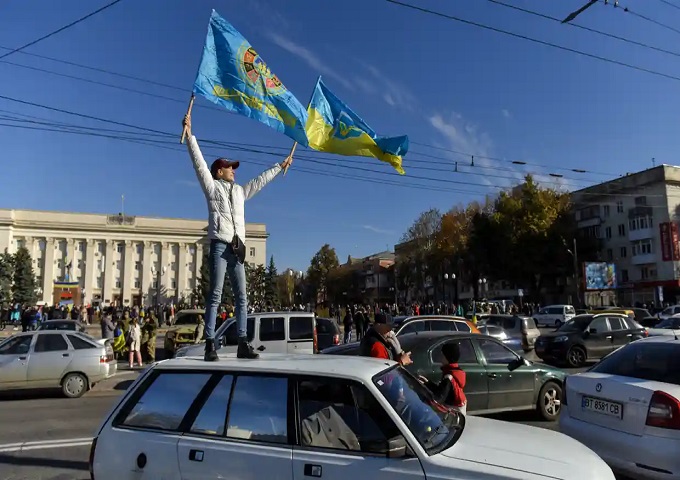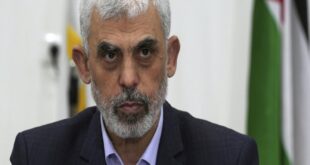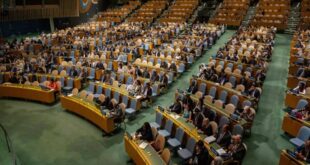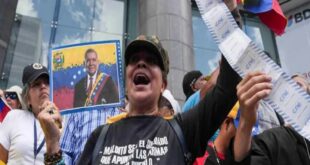
The longer this war lasts, the higher the chances that it will spill over into Nato territory. Last night’s missile explosions that reportedly killed two people in the Polish village of Przewodów, 20km from the border with Ukraine, are testimony to a dangerous trend of miscalculation that could lead to escalation. As long as Russia continues its desperate tactic of missile barrages against civilian infrastructure, this risk is high.
But while attention is focused on Russia’s indiscriminate long-range strikes, and the emerging G20 and Nato reactions, Moscow’s position on the ground is weaker than it has been in months. The loss of Kherson last week was a major blow – to the point that even senior Russian commanders have acknowledged setbacks for the first time.
Kherson was a key strategic asset for the Russian invasion: it is a regional capital, an important Black Sea hub and home to a major shipbuilding industry. The region is also the location of the North Crimean canal, a major source of fresh water for Crimea. Russia’s advances in the south of Ukraine earlier this year were aimed at creating a land corridor to Crimea, asserting control over this important trade route and establishing a launch pad for the occupation of Odesa. Now, that is all in jeopardy.
Once Ukraine establishes its positions in the area it will be able to target northern Crimea and put further pressure on Russian supply lines in the south. The Ukrainian army is already attacking positions around the Kinburn Spit on the left bank of the Dnipro river. This could in turn put the Russian occupation of Melitopol and Mariupol at risk and ultimately render the isthmus of Perekop – the narrow strip of land connecting the Crimean peninsula to the rest of Ukraine – vulnerable. Perekop is the door to Crimea. This is significant for the outcome of this war, as it will further weaken Russian capacity to maintain control over the peninsula; Gen Sergei Surovikin, Vladimir Putin’s commander in Ukraine since early October, may need more troops to reinforce defences of Crimea, forcing the Russians to downsize the area of their military campaign.
The operation to retake the city was the result of a carefully planned counteroffensive – the kind of operation many analysts would have considered unthinkable just a few months ago. It began in September as Ukraine targeted bridges and ferry routes, cutting off Russian supply lines over the Dnipro river. The plan to trap Russian formations on the right bank worked. The Kremlin was forced to choose between retreating to save manpower and a part of its military equipment, or leaving both to capture or elimination due to lack of essential supplies and Kyiv’s growing firepower. It opted for the first.
The scale of the loss can be seen in official Russian communication: it is the first defeat officially acknowledged by the senior military leadership. As the only large regional centre captured by Russia without sustaining major destruction, Kherson was an important propaganda tool for Putin’s domestic audiences. From day one the Kremlin presented its “special operation” as a campaign to liberate Russian-speaking “compatriots” from Kyiv’s oppression. The annexation of four Ukrainian regions – including Kherson – after sham referendums in September was meant to bring these territories into the Russian fold permanently.
Putin insisted people in these regions were joining Russia for ever, and billboards reading “With Russia for ever” popped up on many streets of Kherson. Losing Kherson shows that for ever is a short-term notion, and that Putin is not infallible.
The Russian president himself has stayed silent on the retreat, trying to distance himself from failure. His propagandists, however, explain the “disastrous” turn of events with reference to the “unexpected” coalition of more than 50 countries backing Ukraine against Russia. To calm the panic, Putin’s frontman and deputy chair of Russia’s security council, Dmitry Medvedev, has declared that the land will be returned to Russian control. Kremlin spokesperson Dmitry Peskov insists it is still part of Russia despite the retreat. This gap between rhetoric and reality will surely slowly sink in with the wider public in Russia. Combined with Russia’s staggering human and materiel losses to date, this will only increase pressure on Putin.
The G20 summit in Bali further isolated Russia, hitting its international reputation. Russian attempts to cement its own coalition in opposition to the G7 and fuel anti-US sentiments are failing. The global south is unlikely to stick with the losing side for long. President Zelenskiy’s appeal to world leaders provided a clear road map for ending the war: a withdrawal of all Russian forces and the return of Ukraine’s territories.
For Ukraine the liberation of Kherson is also a boost for continued resistance and evidence of the strength of its armed forces. It is further proof that Russia’s forces, the so-called “second army in the world”, are – at best – the second army in Ukraine. Since the start of the war, the overwhelming majority of Ukrainians have believed in their ability to repel Russian aggression. Victories such as Kherson reinforce that conviction.
Despite the celebratory mood, the Ukrainian leadership is cautious. Russia is still a dangerous adversary. Surovikin managed to preserve most of the approximately 30,000 Russian troops who were in Kherson. It is difficult to predict next steps, but the Kherson contingent will probably be redeployed to strengthen Russia’s presence in the eastern military theatre. Russians desperately need a victory and Donbas could now become their main focus. Taking control of the major railway hubs around Pavlivka and Vyhledar would enable the extensive and rapid supply of artillery munitions to the battlefield. Depending on the weather, the war could either continue at the current pace or, if it gets too wet, turn into a heavy artillery duel across large parts of the existing frontline.
For Ukraine to maintain and strengthen its current strategic initiative, western resolve and assistance remain key. Kherson is yet more proof that military aid to Ukraine is effective. Ukraine has liberated about 50% of the territory taken by Russia since the start of the war. A premature push for negotiations would allow Putin to consolidate his positions and mount new attacks.
Kherson proves that Ukraine can win this war. Video footage of local people greeting Ukrainian soldiers in surrounding villages and in Kherson’s central square speaks volumes. Old ladies hand out apples and abandoned bullets to Ukrainian soldiers; residents dig up Ukrainian flags hidden in glass jars in their gardens. Those flags flying again over Kherson must serve as a constant reminder that this outcome is attainable as we face new challenges in the months to come.

By Orysia Lutsevych is the head of Ukraine Forum at Chatham House – Theguardian




 World Opinions Débats De Société, Questions, Opinions et Tribunes.. La Voix Des Sans-Voix | Alternative Média
World Opinions Débats De Société, Questions, Opinions et Tribunes.. La Voix Des Sans-Voix | Alternative Média




